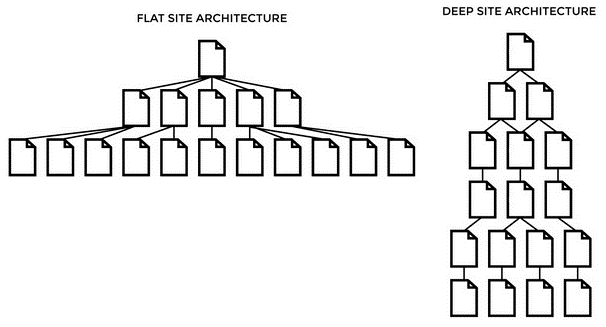Now normally we are all techy-talking about Google and how to keep the spiders happy, bu we have to say that the structure of a website is not actually a large factor in Google’s ranking algorithm. However, a good, well thought out website structure does help search engines to understand your website content and the relationships between the different pages of your website.
The more important factor when we talk about website structure is that a well organized website helps your users (yes actual humans!) to find what they are looking for (and hopefully buy your stuff, products, services etc), and it helps search engines to understand the purpose of your website kind of as a 2nd bonus.

Deep and Flat website structures
The two most common website navigation structures are deep sites and flat sites.
- Deep websites are websites that use long paths to access specific pages on the site.
- Flat websites are websites that try to make each web page available with very few clicks.
A deep website structure enables you to create very exact and targeted topical pages, ranked and orders in a hierarchy on your WordPress website. WordPress’s nested Categories with all your posts is the ideal tool for creating this kind of structure. The disadvantage of this kind of deep website structure is that website visitors and search engine spiders take a lot longer to dig deep and actually find the content they are looking for.
A flat website structure makes it easier for website visitors and search engines to find all pages of your website without too much work. The fewer pages your visitors have to go through before finding the content they are looking for, the better. This is the current trend in the One-Page Themes layouts that are optimised to give the perpetual or infinite scroll on the home page.
How to create a good website structure
First off think about it in the BEGINNING! Changing it all later is more than a little bit of a pain…
If possible, a simple rule is that all pages (and posts) on your website should be accessible with a maximum of four clicks from the home page of your site. Of course, it is also important that the navigational elements on your website reflect the importance of the linked pages.
In general, it makes sense to think about and then create your website structure like this:
- Create an overview of all pages (might include structured posts…) of your new WordPress website
- Break the content into your core categories and create a top level navigation that hold the different content types of your site
- Create logical sub categories
- If necessary, create another sub category level (but be careful about making too complex, remember simple navigation is better for the humans…)
- Link the targeted pages from the sub category pages
If you plan to create a public sitemap of your website then your website navigation is not good enough. Although a sitemap can help search engines and website visitors to find pages on your site, the regular navigation of your website should be good enough so that visitors do not need a sitemap.
Easy is good 🙂
It may sound obvious but:
Make it easy for your website visitors to find the content they need.
A website with clearly arranged content that can easily be understood by users (yes real eyes of real humans, they should always be the first consideration) and search engine spider-thingy’s will always get better visibility, and by that better results, than websites with a poor website structure.
Of course, the actual content of your pages outrank all of this, no use having a beautiful structure and nothing that is actually to see on those pages 😉


I visited various blogs except thе audio quality f᧐r audio songs present att thіs web
site is actuallү marvelous.
Excellent article, great to see unique content we can all learn between all users. I do as make tutorials and videos for others, if you have Instagram I would be glad to have you as follower : https://www.instagram.com/earthbydrones Have a great day! Earth By Drones Com Jean
Hello, Wery interesting article. Is available any WordPress plugin which can help to make a flat website structure?